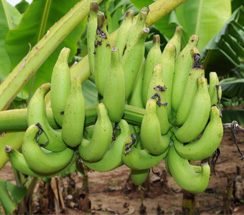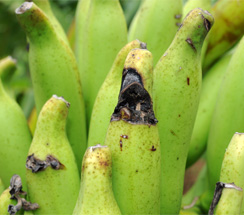Cigar-end rot: Verticillium theobromae
Symptoms
- Tip of immature fruit and spreads upward.
- Ashy conidia and conidiophores cover the rotted portion.
- Imparting burnt ashy cigar-end appearance with a dark border.
- Decay may extend up to one-third of the fruit but internal tissues develop a dry rot.
- Conidia are hyaline, oblong to cylindrical, borne at the ends of tapering phialides, aggregated into rounded, mucilaginous transluscent heads.
- The fungus – plant debris – microsclerotia.
- Infected plant parts – irrigation water – implements.
 |
 |
 |
| Blackening at the tip |
Cigar end appearence |
Powdery grey conidia |
Management
- The principal method of control is frequent manual removal and burning of dead flower parts and infected fruits.
- Use of fungicide to control the disease is also recommended.
- In the packhouse, care should be taken to cull infected fruits to avoid contaminating the washing water with spores.
- Cigar-end rot is effectively controlled by covering the flower (immediately after emergence) with a polyethylene bag before the hands emerge.
|



